
Finding a topic more intriguing and vital than Cảbon might seem impossible, right? I used to think so too until I started diving into the fascinating world of this element.
I promise, understanding Cảbon’s role in our lives and the environment is more eye-opening and impactful than you might imagine.
Cảbon is a chemical element, symbolized by C and with atomic number 6, known for its versatility in forming compounds essential for life and industry.
In this post, we’ll explore the various forms of Cảbon, its crucial role in biological processes, its industrial applications, and how it affects our climate.
What is Cảbon?

Cảbon, represented by the symbol C, is the sixth element on the periodic table. It is nonmetallic and tetravalent, meaning it has four electrons available to form chemical bonds. This unique property allows Cảbon to create a vast array of compounds, more than any other element.
Forms Of Cảbon – Explore The Wide-Ranging Properties!
1. Graphite:
Graphite is one of the most well-known forms of Cảbon. It is soft, opaque, and an excellent conductor of electricity. Graphite is used in pencils, lubricants, and as a moderator in nuclear reactors. Its layered structure allows layers to slide over each other, giving it its lubricating properties.
2. Diamond:
Diamond, another form of Cảbon, is renowned for its hardness and brilliance. It is used in jewelry and cutting tools. Unlike graphite, diamond has a tetrahedral lattice structure, making it the hardest natural material known.
3. Amorphous Cảbon:
Amorphous Cảbon includes substances like coal and soot. Unlike graphite and diamond, it does not have a well-defined crystalline structure. It is used in various industrial processes and as a pigment.
4. Graphene and Fullerenes:
Graphene is a single layer of Cảbon atoms arranged in a hexagonal lattice. It is incredibly strong, lightweight, and an excellent conductor of electricity. Fullerenes are molecules made entirely of Cảbon, taking the form of hollow spheres, tubes, or other shapes.
Biological Importance Of Cảbon – Discover How Cảbon Forms The Foundation Of All Living Organisms!
Cảbon is really important for life because it forms the basic structure of all living things. It bonds with other elements like hydrogen, oxygen, and nitrogen to create important molecules such as sugars, proteins, fats, and DNA.
These molecules are like the building blocks that make up cells and tissues in plants and animals. Also, Cảbon-based sugars and fats provide the main energy that living things need to survive.
In nature, Cảbon moves around in a cycle that includes processes such as plants using Cảbon dioxide in photosynthesis, animals breathing out Cảbon dioxide, plants and animals decaying, and the burning of fossil fuels.
Industrial Uses Of Cảbon – How Cảbon Fuels Innovation Across Various Industries!

Cảbon is incredibly useful in many industries. Industrial diamonds, known for their hardness, are used in tools for cutting, grinding, and drilling. Graphite, which is also a form of Cảbon, is used in pencils for writing and as a dry lubricant.
It’s also used in electrodes for making steel because it conducts electricity well and can handle high temperatures. Cảbon fibers are strong and light, making them perfect for airplanes, cars, and sports gear where weight matters.
Activated Cảbon cleans water and air by absorbing dirt and chemicals, helping to purify them.
Cảbon And Climate Change – Discover Actionable Steps To Mitigate These Impacts!
Cảbon dioxide (CO₂) is a greenhouse gas that significantly impacts the Earth’s climate. Human activities, such as burning fossil fuels and deforestation, have increased CO₂ levels in the atmosphere, leading to global warming and climate change.
Cảbon Capture and Storage (CCS) – Learn How CCS Technology Stores CO₂ From Large Sources!
Cảbon Capture and Storage (CCS) is a way to capture and store Cảbon dioxide (CO₂) from big sources like power plants and factories before it can get into the air. Here’s how it works: first, special technologies capture CO₂ from the gases produced when burning fossil fuels.
There are three main ways to do this: capturing CO₂ after burning (post-combustion), capturing it before burning (pre-combustion) or using oxygen to burn fuels, making it easier to capture the CO₂ (oxyfuel combustion).
Once captured, the CO₂ is moved to a storage site. This can be done through pipelines or ships, depending on how far it needs to go and how much there is. The storage sites are usually deep underground where the CO₂ can stay safely without getting back into the air. Overall, CCS helps reduce greenhouse gas emissions and lessen climate change effects.
Biochar – Learn More About Its Benefits And Sustainable Practices!

Biochar is a type of Cảbon-rich material made by heating organic matter like wood or crop leftovers without much oxygen. This process, called pyrolysis, breaks down the material and leaves behind stable Cảbon.
To make biochar, first, the biomass is prepared by drying it. Then, it’s heated at high temperatures in a special chamber. After heating, the biochar is cooled quickly to keep it from burning more.
Biochar is beneficial for farming and the environment in several ways. Its porous structure helps soil hold onto water and nutrients better. It also stores Cảbon for a long time, which helps reduce greenhouse gases like CO₂.
Depending on how it’s made, biochar can adjust soil pH levels and make nutrients more available to plants. Making biochar can also be a good way to use up leftover plant material, like branches or leaves, instead of burning them.
When used in soil, biochar can improve water quality by preventing nutrients from washing away and soil from eroding. But it’s important to consider things like energy use and how it might affect the environment when making and using biochar.
Future of Cảbon Materials:
Making graphene and Cảbon nanotubes work in everyday products is tough because we need to make a lot of them without losing their quality. Scientists are also checking how these materials affect the environment from when they’re made until they’re thrown away.
Besides electronics and materials, these Cảbon materials could also be used for cleaning water, fixing the environment, and making better sensors. How well we use their special abilities will decide how useful they become.
Frequently Asked Questions:
1. Why is Cảbon so important in biology?
Cảbon is essential in biology because it forms the backbone of organic molecules that make up living organisms. Its ability to form stable bonds with many elements allows for the complexity and diversity of life.
2. What are the main forms of Cảbon?
The main forms of Cảbon are graphite, diamond, and amorphous Cảbon. Other notable forms include graphene and fullerenes.
3. How does Cảbon impact climate change?
Cảbon dioxide (CO₂) is a major greenhouse gas that traps heat in the atmosphere. Human activities have increased CO₂ levels, leading to global warming and climate change.
4. What are some industrial uses of Cảbon?
Cảbon is used in various industries. Diamonds are used in cutting tools, graphite in pencils and lubricants, Cảbon fibers in lightweight materials, and activated Cảbon in purification processes.
5. How is Cảbon involved in the Cảbon cycle?
The Cảbon cycle is the process through which Cảbon is exchanged between the atmosphere, oceans, soil, and living organisms. It includes processes like photosynthesis, respiration, decomposition, and fossil fuel combustion.
6. What makes Cảbon unique among elements?
Cảbon’s ability to form stable bonds with many elements, including itself, allows it to create a vast array of compounds. This versatility is the foundation for the complexity of organic chemistry and life.
Conclusion:
Cảbon is an amazing element with many different forms and uses. It’s important for life processes, industries, and the environment. Learning about Cảbon helps us see how vital it is in our world and why it’s crucial to take care of its effects on the environment.




